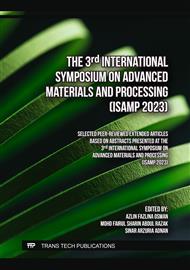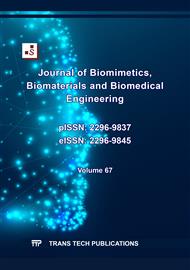[1]
Qarajehdaghi, M., et al., Quaternary composite of CdS/g-C3N4/rGO/CMC as a susceptible visible-light photocatalyst for effective abatement of ciprofloxacin: Optimization and modeling of the process by RSM and ANN. Process Safety and Environmental Protection, 2023. 169: pp.352-362.
DOI: 10.1016/j.psep.2022.11.030
Google Scholar
[2]
Tamyiz, M., et al., Enhanced visible-light-responsive photodegradation of ciprofloxacin by direct Z-scheme ZnFe2O4@g-C3N4 nanocomposites. Journal of Photochemistry and Photobiology A: Chemistry, 2023. 443: p.114897.
DOI: 10.1016/j.jphotochem.2023.114897
Google Scholar
[3]
Deng, Y., et al., Construction of plasmonic Ag modified phosphorous-doped ultrathin g-C3N4 nanosheets/BiVO4 photocatalyst with enhanced visible-near-infrared response ability for ciprofloxacin degradation. Journal of hazardous materials, 2018. 344: pp.758-769.
DOI: 10.1016/j.jhazmat.2017.11.027
Google Scholar
[4]
Sha, J., et al., Diametrically opposite effect of Cu2+ on sulfamerazine and ciprofloxacin adsorption-photodegradation in g-C3N4/visible light system: behavior and mechanism study. Chemical Engineering Journal, 2022. 428: p.131065.
DOI: 10.1016/j.cej.2021.131065
Google Scholar
[5]
Rafieenia, R., et al., Integration of microbial electrochemical systems and photocatalysis for sustainable treatment of organic recalcitrant wastewaters: Main mechanisms, recent advances, and present prospects. Science of The Total Environment, 2022: p.153923.
DOI: 10.1016/j.scitotenv.2022.153923
Google Scholar
[6]
Tamyiz, M. and R.-A. Doong, Synergetic effect of adsorption and photocatalysis by zinc ferrite-anchored graphitic carbon nitride nanosheet for the removal of ciprofloxacin under visible light irradiation. Open Chemistry, 2023. 21(1).
DOI: 10.1515/chem-2022-0304
Google Scholar
[7]
Lan, Z.-A., G. Zhang, and X. Wang, A facile synthesis of Br-modified g-C3N4 semiconductors for photoredox water splitting. Applied Catalysis B: Environmental, 2016. 192: pp.116-125.
DOI: 10.1016/j.apcatb.2016.03.062
Google Scholar
[8]
Mafa, P.J., et al., Multi-elemental doped g-C3N4 with enhanced visible light photocatalytic Activity: Insight into naproxen degradation, kinetics, effect of electrolytes, and mechanism. Separation and Purification Technology, 2022. 282: p.120089.
DOI: 10.1016/j.seppur.2021.120089
Google Scholar
[9]
Deng, X., et al., Boosting interfacial charge separation and photocatalytic activity of 2D/2D g-C3N4/ZnIn2S4 S-scheme heterojunction under visible light irradiation. Journal of Alloys and Compounds, 2022. 894: p.162209.
DOI: 10.1016/j.jallcom.2021.162209
Google Scholar
[10]
Zhang, Y., et al., CNTs boosting superior cycling stability of ZnFe2O4/C nanoparticles as high-capacity anode materials of Li-ion batteries. Journal of Alloys and Compounds, 2022: p.165135.
DOI: 10.1016/j.jallcom.2022.165135
Google Scholar
[11]
Yang, H., et al., An efficient construction method of S-scheme Ag2CrO4/ZnFe2O4 nanofibers heterojunction toward enhanced photocatalytic and antibacterial activity. Colloids and Surfaces A: Physicochemical and Engineering Aspects, 2022. 641: p.128603.
DOI: 10.1016/j.colsurfa.2022.128603
Google Scholar
[12]
Wang, S. and J. Wang, Magnetic 2D/2D oxygen doped g-C3N4/biochar composite to activate peroxymonosulfate for degradation of emerging organic pollutants. Journal of Hazardous Materials, 2022. 423: p.127207.
DOI: 10.1016/j.jhazmat.2021.127207
Google Scholar
[13]
Wu, Y., et al., Boosting 2e− oxygen reduction reaction in garland carbon nitride with carbon defects for high-efficient photocatalysis-self-Fenton degradation of 2, 4-dichlorophenol. Applied Catalysis B: Environmental, 2022. 307: p.121185.
DOI: 10.1016/j.apcatb.2022.121185
Google Scholar
[14]
Nguyen, T.B., C. Huang, and R.-A. Doong, Photocatalytic degradation of bisphenol A over a ZnFe2O4/TiO2 nanocomposite under visible light. Science of the Total Environment, 2019. 646: pp.745-756.
DOI: 10.1016/j.scitotenv.2018.07.352
Google Scholar
[15]
Fan, G., et al., Magnetically separable ZnFe2O4/Ag3PO4/g-C3N4 photocatalyst for inactivation of Microcystis aeruginosa: Characterization, performance and mechanism. Journal of Hazardous Materials, 2022. 421: p.126703.
DOI: 10.1016/j.jhazmat.2021.126703
Google Scholar
[16]
AL-Shwaiman, H.A., et al., Fabrication of intimately coupled CeO2/ZnFe2O4 nano-heterojunction for visible-light photocatalysis and bactericidal application. Materials Chemistry and Physics, 2022: p.125759.
DOI: 10.1016/j.matchemphys.2022.125759
Google Scholar
[17]
Matli, P.R., et al., Fabrication, characterization, and magnetic behavior of porous ZnFe2O4 hollow microspheres. International Nano Letters, 2015. 5(1): pp.53-59.
DOI: 10.1007/s40089-014-0135-2
Google Scholar
[18]
Nguyen, T.B. and R.-A. Doong, Heterostructured ZnFe2O4/TiO2 nanocomposites with a highly recyclable visible-light-response for bisphenol A degradation. RSC Advances, 2017. 7(79): pp.50006-50016.
DOI: 10.1039/c7ra08271a
Google Scholar
[19]
Sarkar, P., S. De, and S. Neogi, Microwave assisted facile fabrication of dual Z-scheme g-C3N4/ZnFe2O4/Bi2S3 photocatalyst for peroxymonosulphate mediated degradation of 2, 4, 6-Trichlorophenol: the mechanistic insights. Applied Catalysis B: Environmental, 2022. 307: p.121165.
DOI: 10.1016/j.apcatb.2022.121165
Google Scholar
[20]
Shi, Y., et al., Engineering of 2D/3D architectures type II heterojunction with high-crystalline g-C3N4 nanosheets on yolk-shell ZnFe2O4 for enhanced photocatalytic tetracycline degradation. Materials Research Bulletin, 2022: p.111789.
DOI: 10.1016/j.materresbull.2022.111789
Google Scholar



